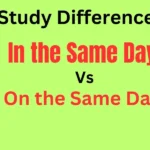Last updated on October 21st, 2024 at 03:45 pm
Understanding the difference between “have” and “had” is crucial for mastering English grammar.
Whether you’re a native speaker or learning English as a second language, grasping these concepts can significantly enhance your communication skills.
This guide delves deep into the uses, nuances, and common pitfalls of “have” and “had,” providing you with everything you need to know.
Let’s break it down step by step.
Understanding the Basics
Definition of “Have”
“Have” is a versatile verb used in various contexts. Primarily, it functions as a main verb and an auxiliary verb.
- As a main verb, it denotes possession or ownership.
- Example: I have a car.
- As an auxiliary verb, it helps form perfect tenses.
- Example: She has finished her homework.
Definition of “Had”
“Had” is the past tense of “have.” It serves as both a main verb and an auxiliary verb, often indicating past possession or actions completed before another past action.
- As a main verb, it shows past possession.
- Example: They had a house in the countryside.
- As an auxiliary verb, it forms the past perfect tense.
- Example: She had left before I arrived.
The Present and Past: When to Use “Have” Versus “Had”
Understanding when to use “have” and “had” involves recognizing the time frame and the role of each verb in a sentence.
Present Tense Usage
“Have” is used in the present tense to indicate possession, experiences, or actions that are ongoing or habitual. Here’s a breakdown:
- Ownership:
- I have a pen.
- Experiences:
- She has visited France.
- Actions (present perfect):
- They have finished their work.
Examples:
- I have three cats.
- She has never been to New York.
Past Tense Usage
“Had” is used to talk about things that were owned or actions that were completed before another past event.
- Past Possession:
- He had a bicycle when he was a child.
- Completed Actions (past perfect):
- By the time I arrived, they had left.
Examples:
- She had finished her book before the meeting started.
- We had dinner at 7 PM yesterday.
Using “Have” in the Present Tense
Singular vs. Plural
“Have” changes form depending on the subject.
- Singular:
- I have a book.
- She has a dog.
- Plural:
- We have two cars.
- They have a lot of homework.
Tips to Remember:
- Use “has” with singular third-person subjects.
- Use “have” with all other subjects.
Different Contexts
Ownership:
- I have a new phone.
- She has a lot of books.
Actions:
- He has finished his homework.
- They have traveled to many countries.
States:
- I have been tired lately.
- She has felt better since the treatment.
Having trouble with English? We make it simple with easy tips and guides to help you improve.
Start learning and boost your skills Talk Speaker.
The Role of “Had” in Past Tense Expressions
“Had” is indispensable in discussing past actions and states. Here’s how it functions:
Completed Actions
Past Perfect Tense is formed using “had” + past participle. It highlights an action completed before another past action.
Examples:
- By the time we arrived, they had already left.
- She had already eaten when I called her.
Past States
Describing Past Conditions:
- They had a beautiful garden.
- He had a serious accident.
Examples in Context:
- She had a headache all day.
- We had been waiting for hours.
Perfecting the Perfect: Exploring Perfect Tenses with “Have” and “Had”
The perfect tenses utilize “have” and “had” to indicate actions and states related to time. Here’s a closer look:
Present Perfect Tense
Formed using “have/has” + past participle. It connects past actions to the present.
- Structure: Subject + have/has + past participle
- Example: I have finished my homework.
Usage:
- Actions that occurred at an unspecified time before now.
- She has visited Paris.
- Actions that started in the past and continue to the present.
- They have lived here for five years.
Past Perfect Tense
Formed using “had” + past participle. It emphasizes an action completed before another past action.
- Structure: Subject + had + past participle
- Example: He had left before I arrived.
Usage:
- Actions completed before a specific time in the past.
- She had seen that movie before.
- States or conditions in the past.
- They had known each other for years.
Future Perfect Tense
Formed using “will have” + past participle. It indicates actions that will be completed before a specific time in the future.
- Structure: Subject + will have + past participle
- Example: By next year, I will have graduated.
Usage:
- Actions that will be finished before a future time.
- She will have completed the project by tomorrow.
Common Mistakes and Clarifications: “Have Had” and “Had Had”
Understanding the common errors with “have had” and “had had” can help you avoid confusion. Here’s what you need to know:
Misunderstandings
Common Errors:
- Using “have had” incorrectly, such as saying “I have had went” instead of “I have gone.”
Clarifications
Key Points to Remember:
- “Have had” is the present perfect of “have had.” It indicates experiences or actions completed at an unspecified time before now.
- I have had breakfast.
- “Had had” is the past perfect of “have had.” It is used to show that something was completed before another past action.
- She had had enough before the meeting.
Examples:
- I have had a great day. (Present perfect)
- He had had the flu before he started the new job. (Past perfect)
Decoding the Present Perfect: The “Have Had” Construction
The “have had” construction can be tricky. Here’s a detailed look:
Definition and Usage
Present Perfect Tense:
- Formed using “have/has” + past participle of “have” (had).
- Example: I have had enough.
Usage:
- Describes experiences or actions completed at an unspecified time in the past.
- She has had many opportunities.
Table of Examples:
| Tense | Example | Usage |
| Present | I have had a busy day. | Experience or action completed at an unspecified time. |
| Past Perfect | He had had enough. | Action completed before another past action. |
Past Perfect Puzzles: Understanding “Had Had”
The phrase “had had” often confuses learners. Here’s how to master it:
Complexity Explained
“Had had” is the past perfect form of “have had.” It indicates a past action completed before another past event.
Examples:
- She had had dinner before the party started.
- They had had the meeting before the decision was made.
Breaking It Down
Tips to Understand “Had Had”:
- Identify the time frame: Look for the sequence of past events.
- Use context clues: The past perfect sets the stage for another past action.
Enhancing Practical Grammar Skills with Exercises and Tips
Improving your grasp of “have” and “had” involves practice and tips. Here’s how you can hone your skills:
Practice Exercises
Interactive Exercises:
- Fill-in-the-Blanks: Complete sentences using “have” or “had.”
- She ___ already finished the book before the meeting.
- Correct the Mistakes: Identify and correct errors in sentences.
- They have went to the store.
Tips and Tricks
- Focus on Subject-Verb Agreement: Remember to match “have” and “had” with the correct subject.
- Use Mnemonics: Create memory aids, like “Had had, before had.”
Common Pitfalls
Frequent Errors:
- Mixing up “have” and “had.”
- Incorrectly using “had” in present contexts.
Example Corrections:
- Incorrect: She have had a great time.
- Correct: She has had a great time.
Conclusion
Understanding “have” and “had” is fundamental to mastering English grammar. By grasping their definitions, usage, and nuances, you can enhance your language skills significantly. Remember to practice regularly, use helpful tips, and stay curious.
Final Tips
- Practice Regularly: Engage with exercises and real-life usage.
- Seek Feedback: Join forums or language groups to get feedback.
- Stay Curious: Keep exploring and learning new ways to use “have” and “had.”
Additional Resources
For further reading and practice, here are some valuable resources:
- Books: “English Grammar in Use” by Raymond Murphy.
- Websites: Grammarly for grammar checks.
- Forums: English Stack Exchange for questions and discussions.
Feel free to dive deeper into each topic, practice with real-world examples, and keep enhancing your understanding of “have” and “had.” Happy learning!

Amelia Harris, a passionate educator, simplifies English grammar and vocabulary for learners of all levels. With her engaging style, mastering English has never been easie




